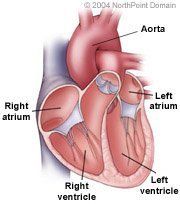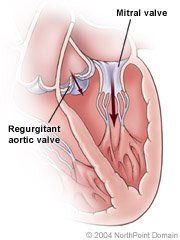Aortic Valve Disease
Basic Facts
- A healthy aortic valve opens widely to allow blood to exit the heart into the aorta and closes tightly to prevent blood from flowing back into the heart.
- Aortic valve disease occurs when the valve is unable to open or close properly.
- Aortic stenosis is a narrowing of the aortic valve that prevents the valve from opening properly, holding back the flow of blood from the heart's left chamber into the aorta.
- Aortic regurgitation occurs when the aortic valve does not close properly between heartbeats, allowing blood to regurgitate, or spill back, from the aorta into the left ventricle.

The heart has four valves: two on the right side of the heart (the tricuspid and pulmonary valves), and two valves on the left side of the heart (the mitral and aortic valves). Resembling flaps, each valve is made up of segments or leaflets, and each opens and closes so that blood flows through the heart in only one direction. A normal aortic valve has three leaflets that seal tightly together when closed. During contraction, the aortic valve opens to allow blood to flow from the left ventricle into the aorta. When the heart relaxes, the aortic valve closes, preventing blood from re-entering the left ventricle. When aortic valve disease is present, the valve no longer opens or closes properly. Common aortic valve problems are aortic stenosis, or narrowing, and aortic regurgitation, or leakage.
Aortic stenosis is the narrowing or obstruction of the aortic valve that prevents it from opening fully, impeding blood flow from the left ventricle to the aorta. Although the heart may initially be able to compensate, the left ventricle must pump harder, which can eventually cause the heart to thicken and enlarge. Eventually the heart may weaken and begin to fail.
Aortic stenosis is common in the United States, primarily affecting people of advanced age.
WHAT ARE THE SYMPTOMS?
A person with aortic valve disease may initially experience no symptoms or mild to moderate symptoms such as fatigue. As valve disease worsens and the body can no longer compensate for problems with blood flow, more serious symptoms may arise, including:
- Congestive heart failure symptoms (most notably shortness of breath, either at rest or accompanying exertion);
- Angina pectoris, or chest pain;
- Back pressure from fluid buildup in the lungs;
- Poor pumping;
- Heart palpitations, or awareness of one's own heartbeat; and
- Arrhythmias, a disturbance in the rate or rhythm of the heartbeat.

CAUSES AND RISK FACTORS
Aortic valve disease can be congenital, or caused by a malformation that is present at birth. For example, some aortic valves do not have the normal three cusps or leafs, leaving them susceptible to damage and to calcium buildup on and around the valve.
Aortic stenosis can occur with age or because of atherosclerosis, or hardening of the arteries.
Causes of aortic regurgitation include:
- Degeneration of the valve leaflets;
- Enlargement of the diameter of the base of the aorta, called aortic root or annular dilatation;
- Endocarditis, a bacterial infection of the inner layer of the heart muscle, or endocardium;
- Dissection of the aorta, or a split or tear in the aorta wall;
- Traumatic injury; and
- Hypertension.
DIAGNOSIS
During an examination, a physician diagnoses aortic valve disease while listening with a stethoscope for heart murmurs, or sounds of abnormal valve function that causes abnormal blood flow through the heart. The physician will confirm the diagnosis by ordering tests, including:
- X rays;
- Echocardiography; and
- Cardiac catheterization and angiography.
TREATMENT APPROACH
People with mild or moderate aortic valve disease may require no treatment but should take certain precautions. For example, they should refrain from severe physical exertion and take antibiotics before and after dental procedures, because of increased susceptibility to endocarditis.
Valve replacement may be required in more severe cases, during which a surgeon replaces the defective valve with a natural or synthetic valve.
Copyright © 2017 NorthPoint Domain, Inc. All rights reserved.
This material cannot be reproduced in digital or printed form without the express consent of NorthPoint Domain, Inc. Unauthorized copying or distribution of NorthPoint Domain's Content is an infringement of the copyright holder's rights.
